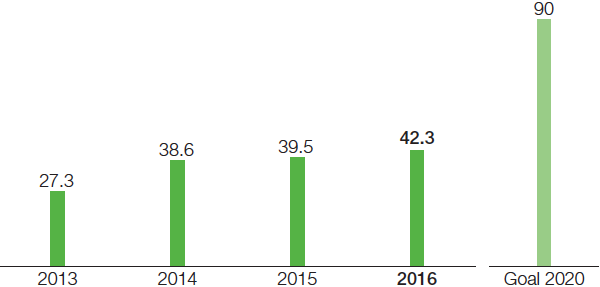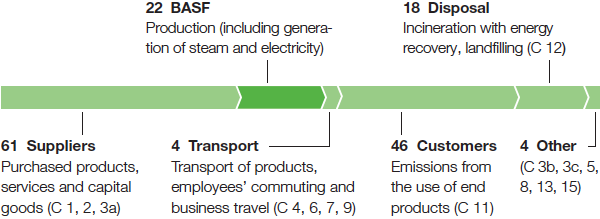Energy and climate protection
As an energy-intensive company, we are committed to energy efficiency and global climate protection. We want to reduce emissions along the value chain and utilize, for example, efficient technologies for generating steam and electricity, energy-efficient production processes, and comprehensive energy management. Our climate protection products make an important contribution toward helping our customers avoid emissions.
![]()
Strategy
- We are committed to energy efficiency and global climate protection along the value chain
We want to reduce greenhouse gas emissions in our production and along the entire value chain. To this end, we have thoroughly analyzed the greenhouse gas emissions from our production in the past few years and implemented comprehensive reduction measures. This is how, for example, we have been able to reduce nitrous oxide emissions by more than 95% since 1997.
Comparisons with European emissions trading benchmarks show that our greenhouse gas-intensive chemical plants operate at above-average efficiency. To supply our production sites with energy, we rely on highly efficient combined heat and power plants with gas and steam turbines, and on the use of heat released by production processes. Around 50% of BASF Group emissions in 2016 resulted from steam and electricity generation in our power plants as well as in our energy suppliers’ power plants.
Our success also depends on the long-term security and competitiveness of our energy supplies. Furthermore, we are committed to energy management that helps us analyze and further improve the energy efficiency of our plants.
We offer our customers solutions that help prevent greenhouse gas emissions and improve energy and resource efficiency. Around half of our total annual research and development spending goes toward developing these products and optimizing our processes.
Our climate protection activities are based on comprehensive emissions controlling. We report on greenhouse gas emissions in accordance with the Greenhouse Gas Protocol Standard, as well as the sector-specific standard for the chemical industry. Since 2004, we have participated in the international non-profit organization CDP’s program for reporting on data relevant to climate protection. Reporting to CDP entails an annual analysis performed by our experts of the opportunities and risks that climate change poses for BASF. BASF achieved a score of A- in CDP’s rating for 2016, awarding it “Leadership” status. Companies on the “Leadership” level are distinguished by factors such as the completeness and transparency of their reporting. They also pursue comprehensive approaches in managing the opportunities and risks associated with climate change as well as emissions reduction strategies to achieve company-wide goals.
We advocate climate protection by supporting initiatives to this end. The G20 Summit will take place in Hamburg in July 2017, an annual meeting between leaders of state and government of the most influential industrialized countries and emerging markets. Companies from 20 countries – the Business 20 (B20) – are working on recommendations for these political leaders. BASF is leading the working group on energy, climate and resource efficiency. The group especially aims for a political environment that enables companies like BASF to make essential contributions to climate protection using their power of innovation.
Reduction of greenhouse gas emissions per metric ton of sales product in BASF operations excluding Oil & Gas1, 2 (%)

1 The figure for 2011 was not adjusted to reflect the scope of consolidation pursuant to International Financial Reporting Standards 10 and 11. For more information on our data collection methods, see data.
2 The figures for the 2011 and 2012 business years were not adjusted to the currently applied factors for global warming potential. For more information on our data collection methods, see this page.
BASF Group’s greenhouse gas emissions according to the Greenhouse Gas Protocol1 |
||||||||||||
BASF operations including Oil & Gas |
|
2002 |
2015 |
2016 |
||||||||
|---|---|---|---|---|---|---|---|---|---|---|---|---|
|
||||||||||||
Scope 12 |
|
|
|
|
||||||||
CO2 (carbon dioxide) |
|
14,634 |
16,496 |
16,215 |
||||||||
N2O (nitrous oxide) |
|
6,407 |
600 |
528 |
||||||||
CH4 (methane) |
|
244 |
88 |
45 |
||||||||
HFC (hydrofluorocarbons) |
|
61 |
119 |
87 |
||||||||
SF6 (sulfur hexafluoride) |
|
0 |
1 |
0 |
||||||||
Scope 23 |
|
|
|
|
||||||||
CO2 |
|
5,243 |
3,795 |
3,884 |
||||||||
Total |
|
26,589 |
21,099 |
20,759 |
||||||||
|
|
|
|
|
||||||||
Sale of energy to third parties (Scope 1)4 |
|
|
|
|
||||||||
CO2 |
|
347 |
1,071 |
1,161 |
||||||||
Total |
|
26,936 |
22,170 |
21,920 |
||||||||
Global goals
- Reduction of greenhouse gas emissions per metric ton of sales product
- Introduction of energy management systems in accordance with ISO 50001
We aim to reduce our greenhouse gas emissions per metric ton of sales product by 40% by 2020, compared with baseline 2002. In 2016, we achieved a reduction of 37.2% (2015: reduction of 34.6%). Since 1990, we have been able to lower our overall greenhouse gas emissions from BASF operations (excluding Oil & Gas) by 50.2% and even reduce specific emissions by 75.4%.
We set ourselves a new energy efficiency goal in 2015 covering both the chemicals and the oil and gas businesses. By 2020, we want to have introduced certified energy management systems (DIN EN ISO 50001) at all relevant production sites5. Taken together, this represents 90% of BASF’s primary energy demand. This is one of the ways in which we intend to identify and carry out improvements in energy efficiency, reducing not only greenhouse gas emissions and saving valuable energy resources, but also increasing the BASF Group’s competitive ability.
2020 Goal
–40%
Reduction of greenhouse gas emissions per metric ton of sales product
Baseline 2002
BASF operations excl. Oil & Gas
2020 Goal
90%
Coverage of our primary energy demand through certified energy management systems at all relevant sites
BASF operations incl. Oil & Gas
In 2016, workshops were conducted in all regions to introduce our energy management systems. This is how, for example, an energy savings potential of over €1 million per year was identified during system implementation at three pilot plants at the largest South American site in Guaratinguetá, Brazil. It is already starting to be realized. All energy efficiency measures are recorded and analyzed in a global database and made available to Group sites as best practices. Currently, over 100 measures are being pursued to reduce energy consumption and increase competitive ability. External audits in accordance with ISO 50001 were already conducted at the first two Chinese sites in the Shanghai metropolitan region in 2016. At the moment, 31 sites are certified worldwide, representing 42.3% of our primary energy demand.
5 The selection of relevant sites is determined by the amount of primary energy used and local energy prices.
Certified energy management systems (ISO 50001) introduced at BASF Group sites worldwide, in terms of primary energy demand (%)

Energy supply of the BASF Group 2016
1 Conversion factor: 0.75 MWh per metric ton of steamSTRENG
Energy supply and efficiency
- Verbund system as important component of our energy efficiency strategy
Gas and steam turbines in our combined heat and power plants enable us to fulfill around 70% of the electricity demand of the BASF Group. Compared with separate methods of generating steam and electricity, we saved 14.0 million MWh of fossil fuels and prevented 2.8 million metric tons of carbon emissions in 2016. The Verbund system is an important component of our energy efficiency strategy: Waste heat from one plant’s production process is used as energy in other plants. In this way, the Verbund saved us around 19.0 million MWh in 2016, which translates to 3.8 million metric tons less of CO2 released to the environment. With combined power and steam generation as well as our continuously enhanced Energy Verbund, we were thus able to prevent a total of 6.6 million metric tons of carbon emissions in 2016.
We were able to further optimize the resource and energy consumption of our production in numerous projects around the world in 2016. New highly efficient combined heat and power plants started up the German sites in Düsseldorf-Holthausen and Illertissen as well as at Pontecchio Marconi in Italy. Furthermore, process improvements at many additional sites have led to savings in steam and electricity.
We also rely on locally available energy sources for energy supply at our sites. Especially in the growing Asian market, we and our energy suppliers also utilize coal as an energy source since the more climate-friendly natural gas is not available in sufficient quantities at competitive prices.
We are exploring the use of renewable energies. These can only become a permanent part of our energy mix if they are competitive in terms of supply security and cost. Our research also contributes to increasing the efficiency of technologies for the use of renewable energy sources.
Key indicators for energy and climate protection in BASF operations excluding Oil & Gas |
||||||||||
|
|
Baseline 20021 |
2015 |
2016 |
||||||
|---|---|---|---|---|---|---|---|---|---|---|
|
||||||||||
Greenhouse gas emissions2 (million metric tons of CO2 equivalents) |
|
24.713 |
20.133 |
19.976 |
||||||
Specific greenhouse gas emissions (metric tons of CO2 equivalents per ton of sales product) |
|
0.897 |
0.587 |
0.564 |
||||||
Primary energy demand3 (million MWh) |
|
55.759 |
57.262 |
57.423 |
||||||
Energy efficiency (kilograms of sales product per MWh) |
|
494 |
599 |
617 |
||||||
Carbon footprint and climate protection products
- Reporting on greenhouse gas emissions along the entire value chain
- Customers’ use of climate protection products sold in 2016 avoids 540 million metric tons of CO2 equivalents
BASF has been publishing a comprehensive corporate carbon footprint since as early as 2008. This reports on all emissions along the value chain and shows the volume of emissions prevented through the use of our climate protection products. We plan our climate protection activities along the value chain based on our corporate carbon footprint.
Through various measures to reduce our raw material and energy requirements, the emission of greenhouse gases associated with producing the raw materials was decreased by a total of around 155,000 metric tons in 2016.
Our climate protection products help us offer solutions to our customers to avoid greenhouse gas emissions over their entire lifecycle as compared with reference products. According to the systematic sustainability analysis we conduct on our portfolio – using the Sustainable Solution Steering® method – such products are referred to as “Accelerator” solutions as using them contributes positively to climate protection and energy. One example is our Green Sense® Concrete technology for sustainable construction: The optimization of the concrete’s composition allows for reduced greenhouse gas emissions compared with conventional concrete production.
Greenhouse gas emissions along the BASF value chain in 20164
(million metric tons of CO2 equivalents)

4 According to Greenhouse Gas Protocol, Scope 1, 2 and 3; categories within Scope 3 are shown in parentheses
An analysis of 24 climate protection product groups revealed that customers’ use of products sold in 2016 helped to avoid 540 million metric tons of CO2 equivalents. Every product makes an individual contribution in the value chain of customer solutions. Value chains are assessed in terms of BASF’s economic share of the respective customer solution. On average, 11% of the emissions avoided were attributable to BASF in 2016. The calculation of avoided greenhouse gas emissions was based on the chemical industry standard of the International Council of Chemical Associations (ICCA) and the World Business Council for Sustainable Development (WBCSD).

